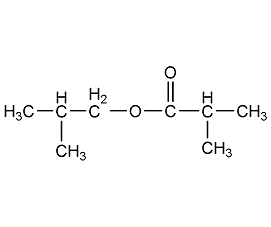Isobutyl isobutyrate Isobutyl Isobutyrate


Structural formula
| Business number | 02CS |
|---|---|
| Molecular formula | C8H16O2 |
| Molecular weight | 144.21 |
| label |
2-Methylpropyl-2-methylpropionate, (CH3)2CHCO2CH2CH(CH3)2, 2-Methyl-propanoic acid 2-methylpropyl ester, 2-Methylpropanoic acid 2-methylpropyl ester, 2-Methylpropyl 2-methylpropionate, 2-Methylpropyl isobutyrate, 2-Methylpropyl 2-methylpropionate, Isobutyl 2-methylpropanoate, Spices raw materials |
Numbering system
CAS number:97-85-8
MDL number:MFCD00008916
EINECS number:202-612-5
RTECS number:NQ5250000
BRN number:1701355
PubChem number:24856807
Physical property data
1. Properties: colorless, pineapple-scented liquid. [1]
2. Melting point (℃): -80.6[2]
3. Boiling point (℃): 147~148.7[3]
4. Relative density (water=1): 0.88 (0℃)[4]
5. Relative vapor density (air=1): 4.97[5]
6. Saturated vapor pressure (kPa): 0.13 (40℃)[6 ]
7. Critical pressure (MPa): 2.61[7]
8. Octanol/water partition coefficient: 2.68[8]
9. Flash point (℃): 38 (CC); 40 (CC) [9]
10 .Ignition temperature (℃): 432[10]
11. Explosion upper limit (%): 7.6[11]
12. Lower explosion limit (%): 1[12]
13. Solubility: insoluble in water, miscible in most organic solvents such as ethanol, ether, acetone, etc. . [13]
14. Solubility parameter (J·cm-3)0.5:16.228
15. Vapor pressure (kPa, 20ºC): 0.43
16. Vapor pressure (kPa, 25ºC): 0.64
17. Heat of evaporation (KJ/mol, 25ºC) : 46.5
18. Heat of evaporation (KJ/mol, b.p.): 38.3
19. van der Waals area (cm2·mol -1): 1.317×1010
20. van der Waals volume (cm3·mol-1): 93.670
21. Liquid phase standard hot melt (J·mol-1·K-1): 271.0
Toxicological data
1. Acute toxicity: rat oral LD50: 12800mg/kg; rat inhalation LC50: 5000ppm/6H; mouse oral LDLo: 12800mg/kg; rabbit skin contact LD50: >8600mg/kg;
2. Other multiple dose toxicity: oral TDLo in rats: 126 mg/kg/18W-I;
3. It is slightly toxic. It is mildly irritating to the skin and can cause anesthesia if inhaled in large quantities. Rats died after intraperitoneal injection of 6.3g/kg, and mice died after intraperitoneal injection of 1.6g/kg.
4. Acute toxicity [14]
LD50: 12800mg/kg (rat oral); 12800mg/kg (Mouse oral); >8600mg/kg (rabbit transdermal)
LC50: 5000ppm (rat inhalation, 6h.�
Ecological data
1. Ecotoxicity No data available
2. Biodegradability No data available
3 .Non-biodegradability[15] In the air, when the concentration of hydroxyl radicals is 5.00×105/cm3 When, the degradation half-life is 3.4d (theoretical).
At 25°C, when the pH value is 7, 8, and 9, the hydrolysis half-life is 9.22a, 336d, and 33.6d respectively (theoretical).
4. Other harmful effects[16] This substance may be harmful to the environment, and special attention should be paid to water bodies. .
Molecular structure data
1. Molar refractive index: 40.80
2. Molar volume (cm3/mol): 164.8
3. Isotonic specific volume (90.2K ): 369.9
4. Surface tension (dyne/cm): 25.3
5. Dielectric constant:
6. Dipole moment (10-24cm3):
7. Polarizability: 16.17
Compute chemical data
1. Reference value for hydrophobic parameter calculation (XlogP): 2.5
2. Number of hydrogen bond donors: 0
3. Number of hydrogen bond acceptors: 2
4. Number of rotatable chemical bonds: 4
5. Number of tautomers: none
6. Topological molecule polar surface area 26.3
7. Number of heavy atoms: 10
8. Surface charge: 0
9. Complexity: 106
10. Number of isotope atoms: 0
11. Determine the number of atomic stereocenters: 0
12. Uncertain number of atomic stereocenters: 0
13. Determine the number of chemical bond stereocenters: 0
14. Number of uncertain chemical bond stereocenters: 0
15. Number of covalent bond units: 1
Properties and stability
1. It has the general chemical properties of ester and can be hydrolyzed under the action of potassium hydroxide.
2. Stability[17] Stable
3. Incompatible substances[18] Strong oxidizing agent, strong alkali
4. Polymerization hazard[19] No polymerization
Storage method
Storage Precautions[20] Stored in a cool, ventilated warehouse. Keep away from fire and heat sources. The storage temperature should not exceed 37°C. Keep container tightly sealed. They should be stored separately from oxidants and alkalis, and avoid mixed storage. Use explosion-proof lighting and ventilation facilities. It is prohibited to use mechanical equipment and tools that are prone to sparks. The storage area should be equipped with emergency release equipment and suitable containment materials.
Synthesis method
It is obtained by passing isobutanol vapor through a (CuO+A12O3), (ZnO+A12O3) or (CuO+ZnO+A12O3) catalytic column at 350~400℃ and pressure.
Refining method: dry with potassium carbonate or anhydrous sodium sulfate and then distill.
Purpose
1. Used as solvent, plasticizer, and used to synthesize spices, seasonings, etc. [21]
